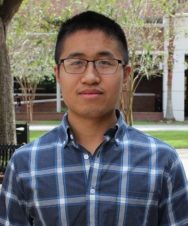Postdoctoral Fellows
George “Gef” Farmer, Ph.D.
 I am a neuroscientist in the Institute for Cardiovascular and Metabolic Diseases where I investigate neural influences on blood pressure and hydromineral balance. I have over 12 years of experience using both in vivo and in vitro neurophysiology techniques.
I am a neuroscientist in the Institute for Cardiovascular and Metabolic Diseases where I investigate neural influences on blood pressure and hydromineral balance. I have over 12 years of experience using both in vivo and in vitro neurophysiology techniques.
I earned my Ph.D. in Cognition and Neuroscience in 2012 from the University of Texas at Dallas where my research focused on learning dependent plasticity in the hippocampus and amygdala following an emotionally arousing task. It was here that I described the time course for changes in post burst afterhyperpolarizations (AHPs) in the hippocampus and amygdala following the acquisition of an emotionally arousing task as well as demonstrating that plasticity in hippocampal AHPs following such a task is dependent on an intact amygdala. My first post doc appointment (2012-2014) was a joint appointment with the University of South Florida and the James A Haley VA Hospital where my research focused on stress and memory in an animal model of post-traumatic stress disorder. Additionally, I was involved in developing an in vitro model of the stress responses and its time dependent effects on hippocampal plasticity. My current research interests involve the role of Angiotensin and chloride transport in intermittent hypoxia-induced hypertension and the role of BDNF in the homeostatic regulation of supraoptic neurons.
Selected Publications:
Farmer, G. E., Park, C. R., Bullard, L. A., Diamond D. M. (2014). Evolutionary, Historical and Mechanistic Perspectives on How Stress Affects Memory and Hippocampal Synaptic Plasticity. in M. Popoli et al. (eds.), Synaptic Stress and Pathogenesis of Neuropsychiatric Disorders, Springer Science+Business Media, New York, 2014
Farmer, G. E. and L. T. Thompson (2012). Learning-dependent plasticity of hippocampal CA1 pyramidal neuron postburst afterhyperpolarizations and increased excitability after inhibitory avoidance learning depend upon basolateral amygdala inputs.Hippocampus 22(8): 1703-1719.
Garcia-Oscos, F., Salgado, H., Hall, S., Thomas, F., Farmer, G. E., Bermeo, J., Galindo, L. C., Ramirez, R. D., D’Mello, S., Rose-John, S., Atzori, M. (2012). The Stress-Induced Cytokine Interleukin-6 Decreases the Inhibition/Excitation Ratio in the Rat Temporal Cortex via Trans-Signaling. Biol Psychiatry 71(7): 574-582.
Sarika Chaudhari, M.D., Ph.D.
Sarika.Chaudhari@unthsc.edu
NIH Biosketch
Curriculum Vitae

I am a postdoctoral research associate working under the mentorship of Dr. Rong Ma in the department of Physiology and Anatomy. My research interest involves finding the pathways that are altered during the pathogenesis of development and progresion of diabetic nephropathy (DN) at cellular level so that therapeutic strategies can be established for better treatment outcome for these patients.
I earned my PhD in Integrative Physiology in 2016 from Dr. Rong Ma’s lab where I studied the variation of store operated calcium entry (SOCE) in mesangial cells of kidneys in diabetes using both in vitro experiments in cultured cells and in vivo approaches using diabetic animal models. Renal fibrosis is an important feature of the diabetic nephropathy. My dissertation research revealed that SOCE pathway is in fact renoprotective and diminishes the fibrogenic proteins and hence renal fibrosis. I used a novel nanoparticle-siRNA delivery system to specifically target the mesangial cells for manipulating various proteins in these cells. Further I demonstrated SOCE -induced alteration of various downstream molecular players that are partly responsible for this renoprotective effect of SOCE. Recent advances in research emphasise the role of inflammation in diabetes. Currently as a postdoc, I am interested in studying the the role of various inflammatory markers, their effects and their association with SOCE in diabetic nephropathy.
Selected Publications:
Ma Y, Li W, Yazdizadeh Shotorbani P, Dubansky BH, Huang L, Chaudhari S, Wu P, Wang LA, Ryou MG, Zhou Z, Ma R. Comparison of diabetic nephropathy between male and female eNOS-/- db/db mice. Am J Physiol Renal Physiol. 2019 May 1;316(5):F889-F897
Jiang H, Zou S, Chaudhari S, Ma R. Short Term High Glucose Treatment Decreased Abundance of Orai1 Protein through Posttranslational Mechanisms in Rat Mesangial Cells. Am J Physiol Renal Physiol. 2018 May 1;314(5):F855-F863.
Chaudhari S, Wang Y, Li W, Ma R. Store Operated Ca++ Entry Suppressed TGFβ1- Smad3 Signaling Pathway in Glomerular Mesangial Cells. Am J Physiol Renal Physiol. 2017 Sep 1;313(3):F729-F739.
Chaudhari S, Ma R. Store-operated calcium entry and diabetic complications. Minireview, Exp Biol Med (Maywood) 2016 Feb; 241(4):343-52.
Wu P, Wang Y, Davis ME, Zuckerman JE, Chaudhari S, Begg M, Ma R. Store-operated Ca2+ channel in glomerular mesangial cells negatively regulates extracellular matrix protein expression. J Am Soc Nephrol. 2015 Nov; 26(11):2691-702
Chaudhari S, Wu P, Wang Y, Ding Y, Yuan J, Begg M, Ma R. High glucose and diabetes enhanced store operated Ca++entry and increased expression of its signaling proteins in mesangial cells. Am J Physiol Renal Physiol. 2014; 306(9):F1069-80.
Alexander J. (AJ) Rosenberg, Ph.D.
alexander.rosenberg@unthsc.edu
NIH Biosketch
Curriculum Vitae
 I am a postdoctoral fellow in the Department of Physiology and Anatomy. I am working under the supervision of Dr. Caroline Rickards in the Cerebral and Cardiovascular Physiology Laboratory. My research interests focus on minimizing cardiovascular health disparities in our aging population, with a particular interest in cerebrovascular physiology and cognitive health.
I am a postdoctoral fellow in the Department of Physiology and Anatomy. I am working under the supervision of Dr. Caroline Rickards in the Cerebral and Cardiovascular Physiology Laboratory. My research interests focus on minimizing cardiovascular health disparities in our aging population, with a particular interest in cerebrovascular physiology and cognitive health.
I received my M.S. and Ph.D. in Kinesiology, Nutrition and Rehabilitation Science at the University of Illinois at Chicago (UIC). I am also a certified strength and conditioning coach by the National Association of Strength and Conditioning. During my Ph.D., I was involved in a wide range of applied physiology projects where we sought to understand how the cardiovascular system responds to different physical and physiological stressors, and ultimately how these responses impact human health and function. I gained extensive experience in working with special populations, including individuals with Down Syndrome, Multiple Sclerosis, Parkinson’s Disease, heart failure, chronic kidney disease, and aged individuals (both healthy and diseased). My dissertation work focused on the association between arterial stiffness, systemic flow/pressure pulsatility, and cerebral hemodynamics with aging. The association between arterial stiffness and cerebral flow pulsatility may, in part, explain the relationship between elevated pressure fluctuations and end-organ disease in older adults. My dissertation project established a foundation for my current work as a postdoctoral fellow in Dr. Rickards’ laboratory at UNTHSC. In my primary postdoctoral study, I will be establishing a functional bioassay for early risk assessment of cerebrovascular dysfunction using a “reactive hyperemic” stimulus. Furthermore, I will be exploring cerebral vascular dynamics between males and females (both young and older adults) to determine the implication of sex differences in the detection, treatment and prevention of cerebrovascular disease and the connection to cognitive decline observed with aging.
Selected Publications
Rosenberg, AJ., Lane, AD., Wee, SO., White, DW., Hilgenkamp, T., Fernhall, B., Baynard, T. Healthy Aging and Carotid Performance: Strain Measures and Beta-Stiffness Index. Hypertension Research. In-press: Accepted 2/18/2018.
Schroeder, EC., Rosenberg, AJ., Hilgenkamp, TI., White, DW., Baynard, T., Fernhall, B. Effect of Upper Body Position on Arterial Stiffness: Influence of Hydrostatic Pressure and Autonomic Function. J Hypertens. 2017. PMID: 28704262
Rosenberg, A.J., Wee, S.O., Schroeder, E., Bunsawat, K., Grigoriadis, G., Fernhall, B., Baynard, T. Effect of acute isokinetic resistance exercise on systemic arterial hemodynamics and cerebral blood flow dynamics: Is there a mismatch? [abstract]. Artery Research, Vol. 16, p101–102, 2016.
Kappus, RM., Bunsawat, K., Rosenberg, AJ., Fernhall, B. No Evidence of Racial Differences in Endothelial Function and Exercise Blood Flow in Young, Healthy Males Following Acute Antioxidant Supplementation. Int J Sports Med. 2017. PMID: 28219102.
Lei Wang, Ph.D.
lei.wang@unthsc.edu
NIH Biosketch
Curriculum Vitae
I am a postdoctoral research associate in the Department of Physiology and Anatomy at the UNT Health Science Center.
I received my Ph.D. degree in Pharmacodynamics/Neuroscience at the University of Florida in August 2016. During my PhD training, I studied how the brain renin-angiotensin system regulate behavioral, endocrine, and cardiovascular responses to psychological stress. My research has revealed that deletion of angiotensin type 1 a receptor (AT1a) from the PVN attenuated anxiety-like behavior and diminished sympathetic excitation and pressor response to restraint stress (Wang L et al Physiological Genomics 2016). The altered behavioral and sympatho-cardiovacular responses may be the results of attenuated CRH transcription in the PVN caused by loss of AT1a signaling pathway. Consistent with these results, I also found that optogenetic activation of AT1a neurons within the PVN significantly increased the blood pressure. Another study during my Ph.D. focused on the stress-relieving effect of brain angiotensin converting enzyme 2 (ACE2), the enzyme that convers angiotensin-II (Ang-II) to angiotensin-(1-7), which can activate mas receptor (MasR). This study demonstrated that overexpression of ACE2 in the brain decreased anxiety-like behavior by promoting MasR-mediated GABAergic inhibitory neurotransmission within the basolateral amygdala (Wang L et al Neuropharmacology 2016). The third study of my Ph.D. dissertation showed that selective overexpression of ACE2 in CRH-producing neurons inhibited the activation of the hypothalamic-adrenal-pituitary (HPA) axis and reduced anxiety-like behavior (Wang LA et al Neuropharmacology 2018). Combined, these three studies suggest that brain renin-angiotensin system is heavily involved in the regulation of behavioral, endocrine, and sympatho-cardiovacular responses to stress.
My research in the laboratories of Dr. Steve Mifflin and Dr. J. Thomas Cunningham concerns the central pathways involved in sleep apnea induced hypertension. Exposing rats to intermittent hypoxia (IH) mimics the arterial hypoxemias that occur in patients with sleep apnea, resulting in sympathetic activation and hypertension. My studies have demonstrated that Corticotropin-Releasing Hormone (CRH) derived from the paraventricular nucleus of the hypothalamus activates CRH type 2 receptors in the nucleus of the solitary tract, which may contribute to IH-induced hypertension.
Selected Publications:
Wang LA, de Kloet AD, Smeltzer MD, Cahill KM, Hiller H, Bruce EB, Pioquinto DJ, Ludin JA, Katovich MJ, Raizada MK, Krause EG. Coupling Corticotropin-Releasing-Hormone and Angiotensin Converting Enzyme 2 Dampens Stress Responsiveness in Male Mice. Neuropharmacology. 2018.
de kloet AD, Wang L* (co-first author), Pitra S, Hiller H, Smith JA, Tan Y, Nguyen D, Cahill KM, Sumners C, Stern JE, Krause EG. A Unique ‘Angiotensin Sensitive’ Neuronal Population Coordinates Neuroendocrine, Cardiovascular and Behavioral Responses to Stress. Journal of Neuroscience. 2017.
Wang L, Hiller H, Smith JA, de Kloet AD, Krause EG. Angiotensin type 1a receptors in the paraventricular nucleus of the hypothalamus control cardiovascular reactivity and anxiety-like behavior in male mice. Physiological Genomics. 2016.
Wang L, de kloet AD, Pati D, Hiller H, Smith JA, Pioquinto DJ, Ludin JA, Oh SP, Katovich MJ, Raizada MK, Frazier CJ, Krause EG. Angiotensin converting enzyme 2 decreases anxiety-like behavior by acting on mas receptor in the brain. Neuropharmacology. 2016.


Social media